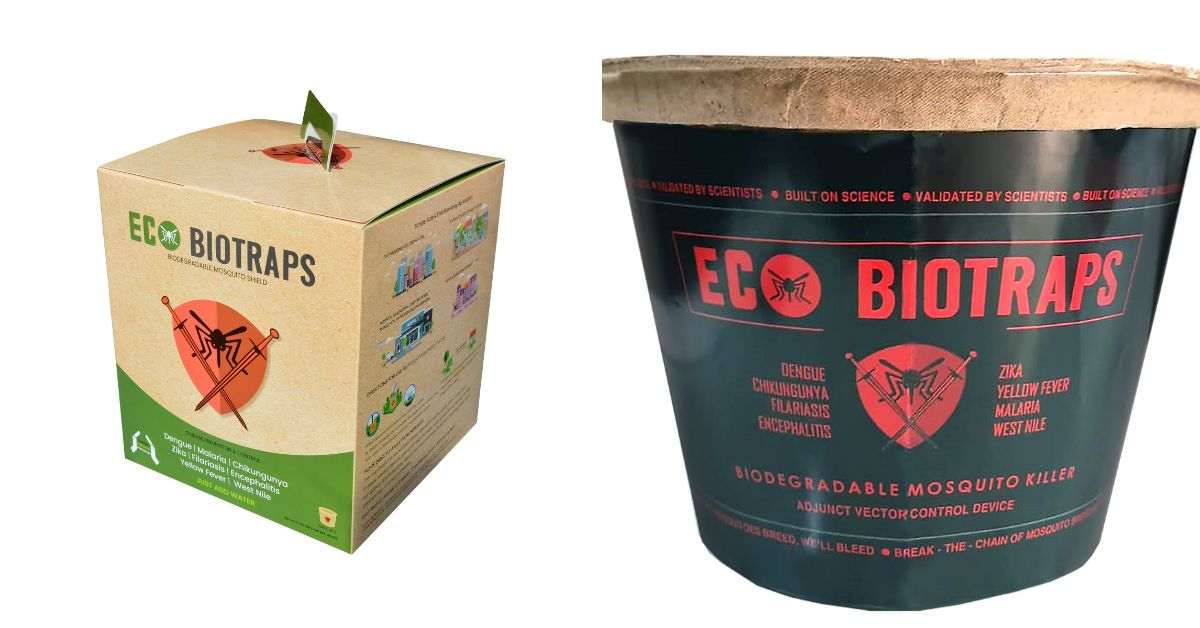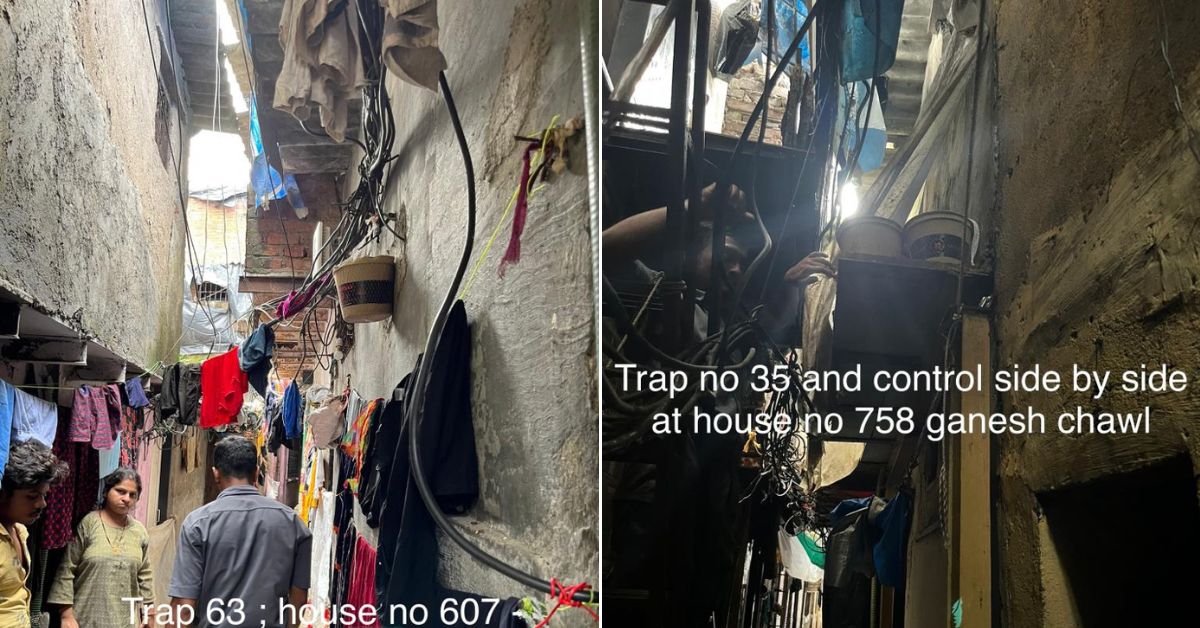This Smokeless & Biodegradable Innovation to Kill Mosquitoes Can Help India Battle Dengue
Developed by Prasad Phadke and his team based out of Ahmedabad, the Eco BioTrap is a 'Made in India' device, which is more affordable than electric vapourisers, mosquito repellents, and coils. It effectively disrupts the mosquito breeding cycle, helping prevent diseases like dengue, malaria, chikungunya, zika etc.

In the summer of 2017, Prasad Phadke had just quit his lucrative corporate job and embarked on an interesting venture aimed at addressing a pressing public health concern.
Working in close collaboration with scientists and other like-minded persons, Prasad had begun developing a product called Eco BioTrap (EBT) aimed at reducing the population of mosquitoes and the incidence of vector-borne diseases they carry like dengue, malaria and chikungunya.
“Sitting at a restaurant in San Francisco, we noticed a lot of mosquitoes buzzing around. It was only earlier that week that cases of West Nile (another vector-borne virus carried by mosquitoes) were reported in the area. Despite the many advances in science and technology, we noted how mosquito-borne diseases showed no signs of abating. The question we asked ourselves was how do we break the chain,” recalls Prasad, speaking to The Better India.
“To address the scourge of mosquitoes, we needed to find a sustainable way of reducing their population and develop a device that could do the same, particularly for tropical regions. There was a clear gap in the marketplace, and we needed to innovate and build a biodegradable device that could break the chain of mosquito breeding,” he adds.
Two years later, Prasad and his team developed the EBT — a population reduction device for mosquitoes that ‘breaks the chain’ of their breeding and provides disease prevention from dengue, malaria, chikungunya, zika and other vector-borne diseases.
Officially incorporated in July 2019 under the EcoBio Group, the venture is based out of Ahmedabad but has operations in cities including Pune, where they manufacture the EBT, and Mumbai as well.

How does it work?
Female mosquitoes who bite humans (males do not) have an average life span of 15 to 30 days. They only breed in water and lay approximately 500–1,000 eggs in their lifetime. The fundamental question here is how do we break the chain of mosquito breeding.
What EBT does is mimic the breeding ground for female mosquitoes.
Before going further into how this device works, it’s important to understand its three core components — a biodegradable container/vase made from recycled corrugated boxes used extensively in the packaging industry; a natural attractant (plant-based animal food) and insect growth regulators (IGRs); and an industry-standard household insecticide.
“The way EBT works is that you add water to the device. The attractant then lures the female mosquito to breed in this container, and then, the killing ingredient (IGR) ensures that no adult emerges, thereby breaking the chain of reproduction. EBT is made from waste and saves lives, and is one that is built on science and validated by scientists,” claims Prasad.
“BioTraps essentially target female mosquitoes by mimicking the ideal mosquito breeding ground to lay their eggs. Our patented waterproofing technology along with a quick and efficient delivery of the IGR solution then eliminates the female mosquito and 100% of her larvae. As a result, not a single adult mosquito emerges from the BioTraps,” he adds.
When pressed further on the specific ingredients of the natural attractant and IGR, Prasad notes, “The natural attractant is animal food and for proprietary reasons, its details can’t be revealed. IGR, meanwhile, is a household insecticide approved by the Government of India and the World Health Organization (WHO), and is widely used in India and worldwide by public health departments. Specifically, however, EBT uses pyriproxyfen granules.”
Entirely made in India and manufactured in their Pune-based factory, a unit of EBT covers an area of around 400 square feet and costs approximately INR 500 (on Amazon).
“Another positive element of the EBT is its cost-effectiveness. Electric vapourisers are 44% more expensive than EBT. When you compare it with repellents like coils or essence sticks, a unit of EBT is about five times cheaper over a four to six-week period,” claims Prasad.

But the question remains of how you should deploy the EBT.
The primary requirement is that it should be positioned in an area with no direct sunlight. “Ideally, the BioTrap should be placed on the floor, in the corners, with minimal movement around, and away from direct sunlight. However, it is also effective in attracting gravid female mosquitoes to lay eggs when positioned at a height of five to seven feet when hung, and up to nine feet if placed on a surface,” he explains.
And when can you expect to see results? After deploying it for around a week, Prasad claims that you will see a noticeable reduction in the number of mosquitoes.
According to their website, “The most significant reduction occurs when the Eco BioTraps are continually used over an extended period.” It adds, “The effectiveness of mosquito population reduction is further evidenced by the presence of Aedes eggs found on the inner walls of Eco BioTraps. By eliminating these eggs, Eco BioTraps effectively ‘Break-The-Chain’ of mosquito breeding, contributing to the overall control of the mosquito population.”
Once its shelf life comes to an end after four to six weeks (marked by water leakage), the used unit of EBT should be treated as dry waste and recycled accordingly.
Challenges in developing EBT
A significant challenge in developing the EBT was finding the right biodegradable material that would hold water for four to six weeks and not turn itself into a breeding ground.
“Take the example of an egg tray. It uses the same material used in EBT. However, if you pour water in an egg tray, it will not be able to hold water for seconds,” notes Prasad.
“The challenge was how to ensure that similar material holds water for a month or more. A lot of permutations and combinations were done. The product now has patents in over 50 countries for its unique ability to hold water. We cannot delve into more detail about the technology employed because of its proprietary nature. Overall, it has taken more than seven years of development and around five iterations to arrive at the final product,” he adds.
Testing EBT in Dharavi
Recently, the Brihanmumbai Municipal Corporation (BMC) used EBT in Asia’s largest slum, Dharavi, as part of a pilot project. “The trap yielded good results as it was user-friendly and safe for the environment. Another plus point of EBT is that unlike other devices used for the prevention of mosquito breeding, this trap doesn’t require electricity,” notes Dr Susanta Kumar Ghosh, a scientist formerly with the National Institute of Malaria Research.
With the support of the ICICI Foundation and BMC’s Insecticide Department, the EBT team embarked on an eight-month-long scientific evidence-generation exercise in Dharavi last year. They covered three pockets of the slum — Rajiv Gandhi Nagar, Mahim Phatak, and Kumbharwada. A total of 3,000 EBTs were deployed every month in these three areas, covering approximately 10,000 households and a population of 80,000.
“When Prasad and I first went into Dharavi to pilot test the EBT, we were stunned by the density and complexity of Dharavi’s topography. It’s like a dense forest where the shanties are so tightly built together that barely any light can penetrate through. In the lanes of Dharavi, you cannot even open an umbrella and walk,” recalls Dr Ghosh.
“Therefore, the EBT without a hanging mechanism was impossible to deploy, and I recall Prasad telling me, ‘Dada, we’ve failed even before we start’. Deepak, the manufacturing head at the EcoBio Group, and his team took up the challenge and developed a mechanism to solve the problem with the hanging net that needed to be biodegradable, hold the weight of the pot (two litres with water), and not get squashed under Mumbai’s torrential rain,” he adds.

The marked success of this pilot project garnered Prasad and his team a lot of acclaim with CNN News18 even featuring their work in a 10-minute documentary — as part of their ‘Changemakers’ series which was aired in November 2022.
Speaking at an event commemorating World Dengue Day 2022, Rajan Naringrekar, the insecticide officer at the BMC, noted, “The dengue mosquito is a domestic, peri-domestic and container breeder, and one of the challenges we’re facing was the access to houses and workplaces. Eco Biotraps is an apt solution to solve this challenge.”
Looking Ahead
Moving ahead, Prasad claims that the EBT team “are in the final stages” of striking partnerships with various municipal corporations and government organisations in India and other South Asian countries.
“Rentokil PCI, India’s largest pest control provider, recently signed an agreement that makes EBT available in 1000+ RPCI branches across 21 states in India. What’s more, our venture recently raised an undisclosed amount of seed funding from institutional investors and is valued at Rs 50 crore,” he says.
Can the EBT play a pivotal role in eliminating vector diseases like malaria and dengue?
“The elimination of vector-borne diseases has four key pillars — integrated vector control management, disease management (including surveillance), civic participation, and IEC (information, education and communication). For any elimination to be successful, all four pillars need to work in tandem. I believe Eco BioTraps help facilitate integrated vector control management. What’s more, they are biodegradable and do not emit any toxic chemicals like mosquito coils that are known to induce respiratory distress,” says Prasad. If you found our stories insightful, informative, or even just enjoyable, we invite you to consider making a voluntary payment to support the work we do at The Better India. Your contribution helps us continue producing quality content that educates, inspires, and drives positive change. Choose one of the payment options below for your contribution- By paying for the stories you value, you directly contribute to sustaining our efforts focused on making a difference in the world. Together, let’s ensure that impactful stories continue to be told and shared, enriching lives and communities alike. Thank you for your support. Here are some frequently asked questions you might find helpful to know why you are contributing?

(You can read more about EBT and the team behind it here.)
Edited by Pranita Bhat; All images courtesy: EcoBio Group.
This story made me
- 97
- 121
- 89
- 167















